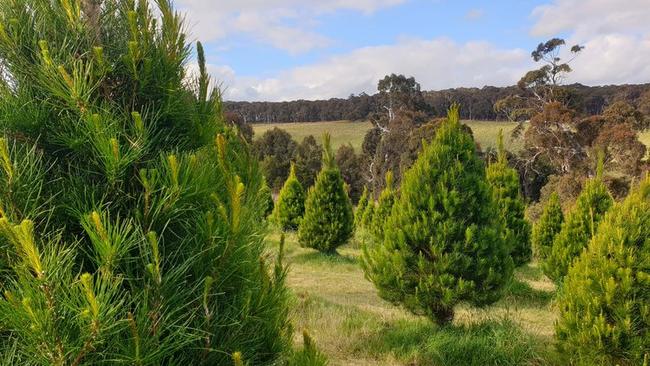Love a real Christmas tree? You need to prepare early
Demand for real trees, cut and potted, has surged in recent years, but supply has been severely impacted.

Our traditional cut Christmas tree in Australia is the radiata or Monterey pine (Pinus radiata), loved for its delicious piney scent. Demand for real trees, cut and potted, has surged in recent years, but this year the supply has been severely impacted. Many tree farms in NSW have been flooded, sometimes several times, killing tens of thousands of trees. The effects will be felt over coming years, too, because it takes five to six years to grow Christmas trees to market size, and huge numbers of young seedlings died this year.
Radiata pines are relatively fast growing with long, soft, needle-like leaves. They are hand-pruned up to four times a year to achieve that dense cone shape we love in a Christmas tree. In Europe, the traditional Christmas tree is Norway spruce (Picea abies), which has short needles on layered branches – ideal for holding decorations – as well as a pungent pine scent. They are available here as potted trees at Christmas time, which families can potentially re-pot and keep growing to use each year, but they grow best in cool climates. Neither they nor potted radiata pines should be planted out in home gardens because they grow too large.
Lawrence Ranson started his Christmas tree business, Spruced, after studying forestry in Germany and Denmark. “In Europe they have a huge range of conifers and the Christmas tree market is far superior to ours in choice and quality,” he says. Returning to Australia, Ranson worked for Forestry NSW before deciding to “disprove the naysayers” by setting up his own Christmas tree farm near Bathurst in NSW, where he found the necessary cold climate and good soil. His aim is to add diversity to the limited offering of Christmas trees in the Australian market, selecting and trialling new varieties for their colour, aroma and textures.
It’s not a business model for the impatient. “Some species are so slow growing, it’s painful to watch,” Ranson laughs. He estimates his experimental Fraser firs (Abies fraseri), one of the most popular species in the US and Canada, will take 10-12 years to reach market size. Norway spruce is faster, “a seven-year crop” from seed to sale as a 1m-1.2m tall tree in a 30cm diameter pot, compared to four years for a radiata pine.
The business sells potted and cut trees, and is also developing the supply of seedlings and seeds to other growers. Cut foliage for florists is another market. In addition to staples such as blue spruce (Picea pungens), Douglas fir (Pseudotsuga menziesii) and noble fir (Abies procera), Ranson is experimenting with other fir species and our native pygmy cypress pine (Callitris oblonga).
The abnormally wet conditions have considerably reduced his stock this year. “We are pretty much sold out now,” he said in late November. “If we had 10,000 trees we would have sold them all.” Sounds like pre-orders will be a good idea next Christmas.
With many perennials and bulbs that die down seasonally in my garden, I tend to forget what’s where and inadvertently damage or remove plants. I use stick labels but is there a more visually aesthetic solution? Gloria Dubczuk, Perth
Find some plant labels you like and stick to one kind for a consistent look. “Tee” labels have a large writing area on a stake that pushes into the ground. If white plastic is not you, there are stylish ones in copper, zinc and bamboo. Use a permanent marker to write with. Tie-on copper labels age to a rustic patina; there are also slate labels used with a white marker pen.
How should we prune and fertilise our Camellia sasanqua hedge, planted in April? Mark Hudson, Merimbula, NSW
Sasanquas put on leaf growth from early spring until they start to set their flower buds in the new year. Frequent tip pruning during this time promotes bushiness; how often depends on the speed of growth. You’d normally stop pruning sasanquas in January to preserve the buds. Apply organic-based fertiliser to moist soil in early spring and early autumn.
Send your questions to: helenyoungtwig@gmail.com or Helen Young, PO Box 3098, Willoughby North, NSW 2068. The best question for December/January wins $200 worth of Neutrog products including POPUL8, Kahoona, Gyganic and Seamungus.


To join the conversation, please log in. Don't have an account? Register
Join the conversation, you are commenting as Logout